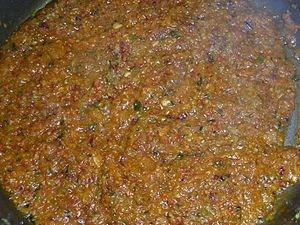Sofrito facts for kids
Sofrito is a special mix of ingredients used as a base for many dishes. Think of it like a flavor starter! It's popular in places around the Mediterranean Sea, Latin America, Spain, and Portugal.
This cooking base usually has chopped-up ingredients. These are often cooked slowly in cooking oil. This slow cooking helps bring out their best flavors.
In modern Spanish cooking, sofrito often includes garlic, onion, peppers, and tomatoes. These are all cooked in olive oil. In Portuguese-speaking countries, this mix is called refogado. It usually has onions and olive oil. Sometimes, tomatoes, garlic, and bay laurel leaves are added too.
Contents
Sofrito in Mediterranean Cooking
In Mediterranean cooking, olive oil is very important. It's a key part of the base, along with tomatoes and onions. Garlic can be added, but it's not always a must-have.
The first recipes for sofrito were found around the 1300s. Back then, it was just onion and oil. Tomatoes and peppers came to Europe much later, after the Americas were discovered. Some sofrito recipes today don't even use tomatoes. Instead, they might add other chopped vegetables like leeks or bell peppers.
Italian Soffritto
In Italian cuisine, a mix of chopped onions, carrots, and celery is called battuto. When this mix is slowly cooked in olive oil, it becomes soffritto. This is a basic part of many Italian dishes. It's often the start for pasta sauces, like bolognese sauce. It can also be used for cooking vegetables. Sometimes, garlic, shallot, or leek are added to it.
Greek Sofrito
In Greek cuisine, the word sofrito means a special dish from the island of Corfu. This dish is a veal steak. It's cooked slowly in a sauce made with white wine, garlic, and herbs. It's usually served with rice.
Sofrito in Latin American Cooking
Sofrito is super important in Latin American cooking. Each country has its own special way of making it!
Brazilian Refogado
In Brazilian cooking, the word refogar means to fry food in vegetable oil before boiling or steaming it. Even if the fried seasoning isn't there, the process is still called refogado. For example, rice that is toasted in oil before boiling is technically refogado.
Colombian Sofrito
In Colombian cuisine, sofrito is known as hogao. This version is made with green onion and tomato. Another type, called guiso, mostly uses tomato, onion, coriander, cumin, and sometimes garlic. It's used in stews, with meats, and in rice dishes. It can also be a dip for foods like arepas.
Cuban Sofrito
In Cuban cuisine, sofrito is made with Spanish onions, garlic, and green bell peppers. It's the base for many dishes. These include beans, stews, and rice dishes like ropa vieja and picadillo. Other things sometimes added are tomato sauce, white wine, cumin, bay leaf, and cilantro. For some recipes, chorizo (a spicy sausage), salt pork, and ham are also included.
Dominican Sazón
In Dominican cooking, sofrito is also called sazón. This is a liquid mix with vinegar, water, and sometimes tomato juice. It's used for rice, stews, and beans. A typical Dominican sazón has finely chopped green, red, and yellow bell peppers, red onions, garlic, oregano, apple cider vinegar, tomato paste, water, and cilantro. The ingredients can change. For example, cubanelle peppers can replace bell peppers.
Ecuadorian Refrito
In Ecuadorian cuisine, sofrito is known as refrito. It's made with Spanish onions, cubanelle peppers, fresh tomatoes, roasted garlic, cilantro, and toasted cumin.
Mexican Sofrito
In the Mexican state of Yucatán, habanero chiles are a key part of their sofrito. These chiles give it a special spicy kick!
Peruvian Aderezo
In Peruvian cuisine, sofrito is called aderezo. It's made with red onion, garlic, and one or more chili pastes, depending on the recipe. Salt and black pepper are also added. Sometimes, aderezo might include tomato or achiote. In North Coast Peru, they sometimes add loche squash.
Puerto Rican Sofrito
In Puerto Rican cuisine, sofrito is mostly used for rice dishes, sauces, and soups. It's very similar to recaíto. The two main ingredients that give Puerto Rican sofrito its special taste are recao (culantro) and ají dulce (sweet peppers). Red and green cubanelle peppers, red bell peppers, pimientos, yellow onions, garlic, plum tomatoes, and cilantro are also added. All red peppers are roasted and seeded before being added.
Sofrito is traditionally cooked with olive oil or annatto oil. Sometimes, bacon, salted pork, and cured ham are used. A mix of stuffed olives and capers, called alcaparrado, is often added. Spices like bay leaf, bixa orellana (achiote), and adobo are also common.
Haitian Épice
In Haitian cuisine, the flavor base for most dishes is called épice. This is a sauce made from cooked peppers, garlic, and herbs. Green onions, thyme, and parsley are especially important. It's used as a basic seasoning for rice and beans. It also goes into stews and soups.
Caribbean Sofrito
In some parts of the Caribbean, sofrito is seasoned lard. It's used as a base for many traditional dishes. It's made differently from other sofritos. First, pork fat is melted down. Then, annatto seeds are added to make the lard yellow. The seeds are then removed. A ground mix of cured ham, bell peppers, chile peppers, and onion is added to the colored lard. After that, mashed coriander leaves (cilantro) and oregano leaves are stirred in. Garlic cloves are added in a tea ball, and the sauce cooks slowly for about 30 minutes.
Sofrito in Asia
Filipino Ginisá
In Filipino cooking, ginisá is a cooking term. It means a base of garlic, onions, and tomatoes cooked together in oil. It's very much like the Spanish sofrito.
Images for kids
See also
 In Spanish: Sofrito para niños
In Spanish: Sofrito para niños



